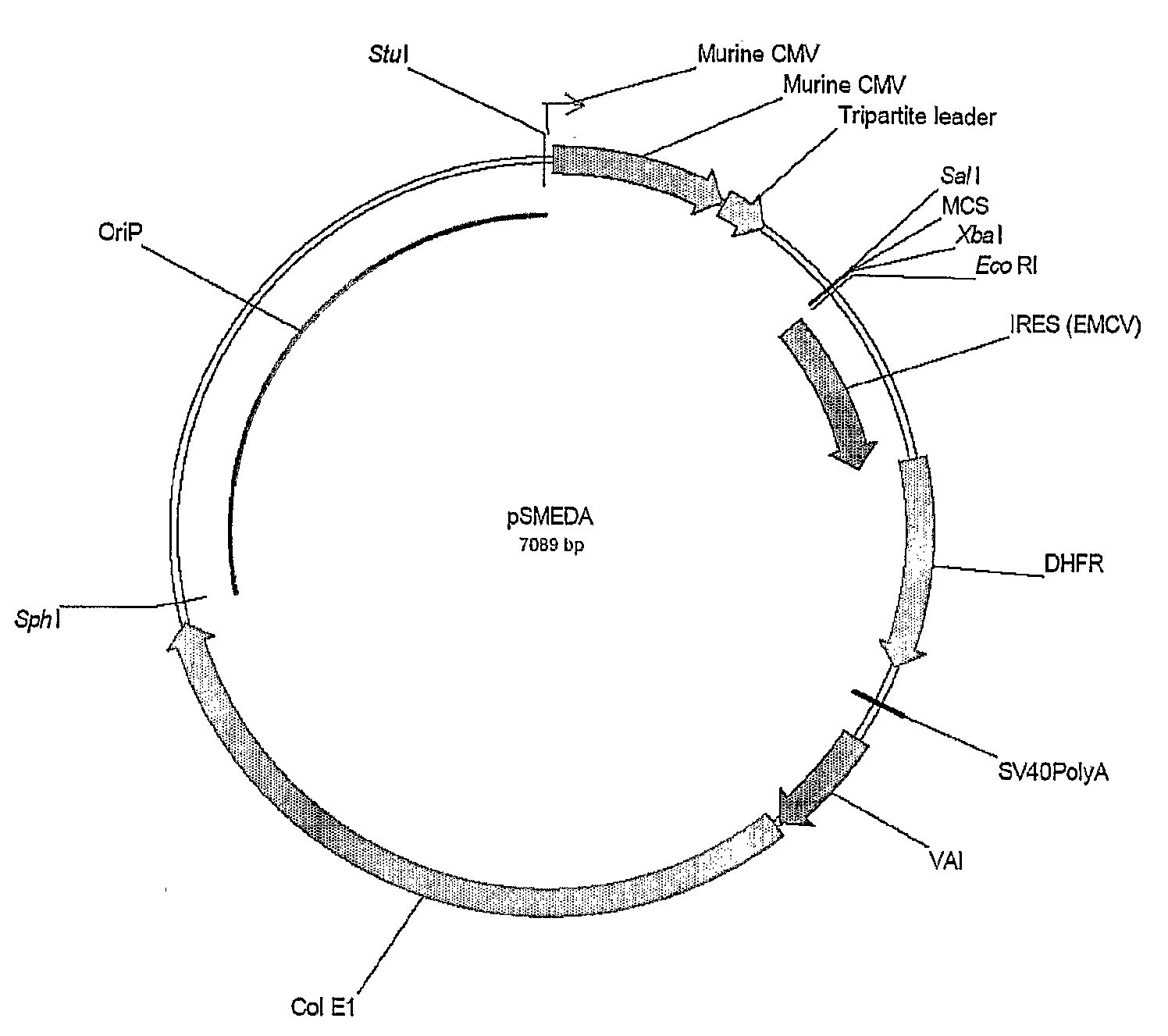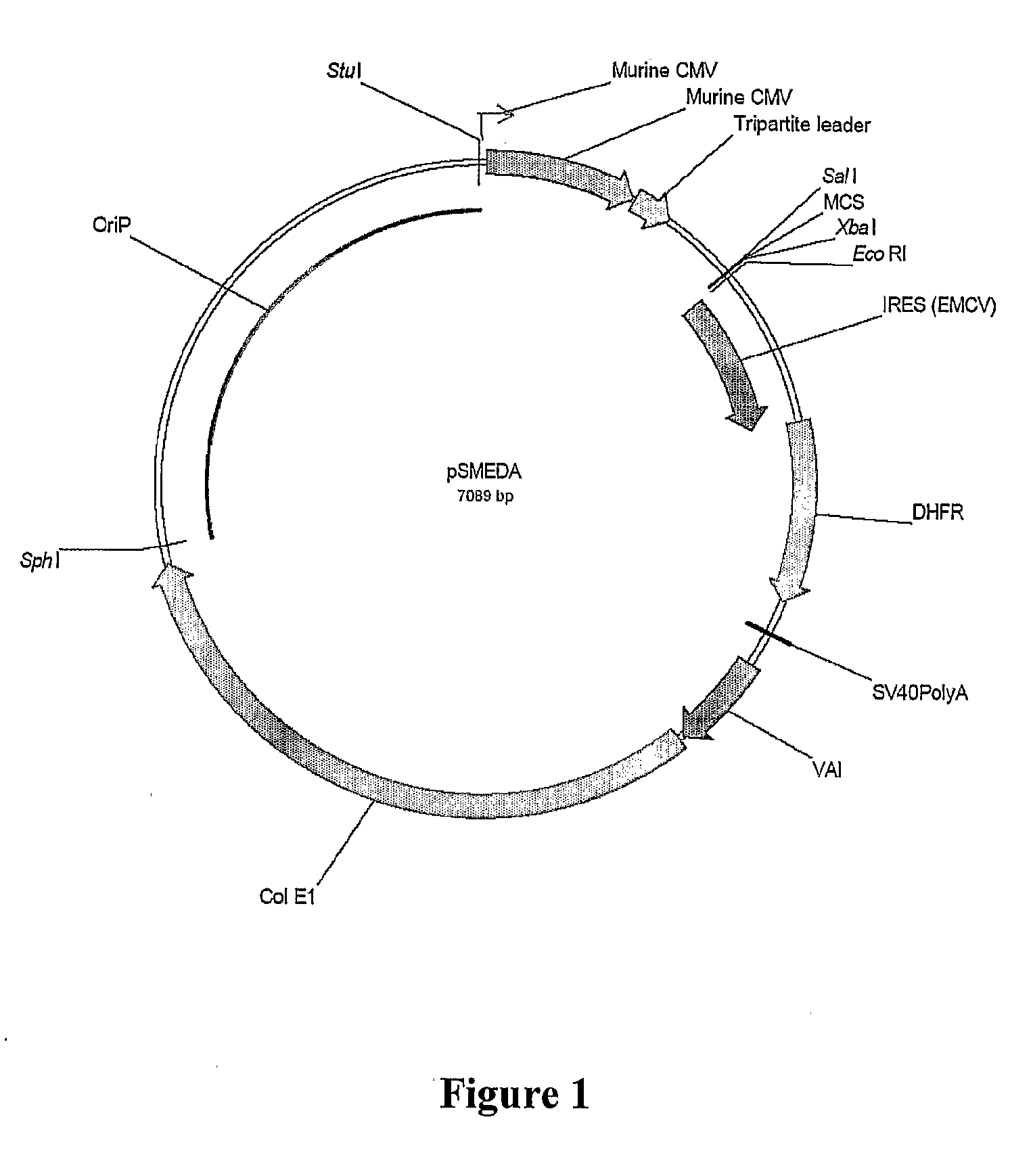Mammalian expression systems
- Summary
- Abstract
- Description
- Claims
- Application Information
AI Technical Summary
Benefits of technology
Problems solved by technology
Method used
Image
Examples
example 1
Cell Culture and DNA Constructs
[0085]Mammalian cell lines (HEK293-FT, HEK293-EBNA, CHO-DUKX, and Lec.3.2.8.1) were grown and maintained in a humidified incubator with 5% CO2 at 37° C. HEK293 cells were cultured in free-style 293 media (Invitrogen) supplemented with 5% fetal bovine serum (FBS). CHO-DUKX stable lines were grown in alpha media containing 10% FBS and 200 mM methotrexate (MTX). HEK293 stable lines were cultured in alpha media containing 10% FBS and 100 nM MTX.
[0086]Transient expression was performed in either 50-ml spinners or 1-L spinners. For 50 ml culture volumes, 25 μg of plasmid DNA were mixed with 400 μg of polyethylenimine (PEI, 25 kDa, linear, neutralized to pH 7.0 by HCl, 1 mg / ml (Polysciences, Warrington, Pa.) in 2.5 ml of serum-free 293 media. For 1 liter culture volumes, 500 μg of DNA were mixed with 4 mg of PEI in 50 ml of serum-free 293 media. The mixtures were then mixed with either 50 ml or 1 liter of HEK293 cells in 293 media with 5% FBS at a cell densit...
example 2
Heparin Enhances sFRP-1 Production by Transfected Cells
[0089]C-terminal his6 tagged sFRP-1 was transiently expressed in HEK293-FT cells as described in Example 1. 50 μg / ml of heparin (Sigma Chemical Co.) was added to the cell culture during or after DNA transfection (“Induction time post-transfection” in FIG. 2). Conditioned media were harvested at different time points (“growing time” in FIG. 2). Protein samples were separated by SDS-PAGE and immunoblotted with mouse monoclonal anti-his4 antibodies (Qiagen) at 0.2 μg / ml (FIG. 2). Immunoblotting was performed as described in Zhong et al. (2004) FEBS Lett. 562:111-117. As illustrated in FIG. 2, heparin significantly increased sFRP-1 production by transfected HEK293 cells. The greatest increase was observed when heparin was added to the culture medium 48 hours after DNA transfection. In other experiments, no such increase was observed for recombinantly-expressed aggrecanase-1 or aggrecanase-2 proteins (data not shown).
[0090]C-terminal...
example 3
FGF-2 Enhances Protein Production by Transfected Cells
[0098]Cells from an HEK293 line stably overexpressing sFRP-1 (clone 100-5) was grown to confluence in a 6-well plate; the media were then replaced with fresh serum-free media containing 50 μg / ml of heparin. 50 ng / ml of fibroblast growth factor-1 (FGF-1, Sigma Chemical Co.) or fibroblast growth factor-2 (FGF-2, Sigma Chemical Co.) were added to the media in corresponding wells. Conditioned media were harvested 48 h after the media replacement. Protein samples were separated by SDS-PAGE and immunoblotted with mouse monoclonal anti-His4 antibody (FIG. 10). As demonstrated in FIG. 10, the combination of FGF-2 and heparin dramatically increased sFRP-1 production by stably transfected HEK293 cells.
[0099]Thus, FGF-2 and heparin appear to regulate protein synthesis post-transcriptionally, as Northern analysis showed that the mRNA level of sFRP-1 is not affected by the presence of heparin (FIG. 5). Without wishing to be bound by theory, h...
PUM
| Property | Measurement | Unit |
|---|---|---|
| Time | aaaaa | aaaaa |
| Concentration | aaaaa | aaaaa |
| Concentration | aaaaa | aaaaa |
Abstract
Description
Claims
Application Information
 Login to View More
Login to View More - R&D
- Intellectual Property
- Life Sciences
- Materials
- Tech Scout
- Unparalleled Data Quality
- Higher Quality Content
- 60% Fewer Hallucinations
Browse by: Latest US Patents, China's latest patents, Technical Efficacy Thesaurus, Application Domain, Technology Topic, Popular Technical Reports.
© 2025 PatSnap. All rights reserved.Legal|Privacy policy|Modern Slavery Act Transparency Statement|Sitemap|About US| Contact US: help@patsnap.com



